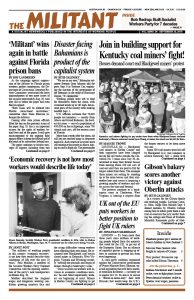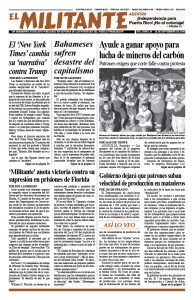“We are on our own,” Bahamian volunteer fireman Greg Johnson told the press Sept. 6 in Treasure Cay, explaining the inaction of the government of the Bahamas in the wake of Hurricane Dorian. “It’s deplorable.”
Working people were left to fend for themselves when the storm, with sustained winds up to 185 mph, devastated parts of the country after making landfall Sept. 1.
U.N. officials estimate that 70,000 people are homeless — mostly from Abaco and Grand Bahamas, the hardest-hit areas — out of a population of 400,000 on the archipelago, some 700 islands and cays, off the eastern coast of Florida.
More than a week after the storm, aid still had not reached many in desperate need of it. And crowds of survivors were still waiting at the airport in Abaco, hoping to catch a flight out. The government continued to say Sept. 10 that deaths stood at 50, but everyone knows the true total is far higher. Decomposing bodies were still visible on the streets.
The class bias of the government was evident from the first evacuation order. Two days before the storm hit, Prime Minister Hubert Minnis told residents of Abaco and Grand Bahamas that those who “are able to do so financially should seek shelter among family members.” Flights to more protected islands were increased — for those who could afford a ticket.
Distrust of the government, especially in areas that are predominantly Haitian immigrants and those of Haitian descent, kept many from going to shelters.
In recent years, the Bahamian government has deported hundreds of Haitians, many of whom have lived in the Bahamas for decades. Even their Bahamas-born children aren’t granted citizenship. One in 10 Bahamians are of Haitian descent. Many other Bahamians are descendants of African slaves brought there by U.S. colonists fleeing the American Revolution and pro-slavery English settlers.
Working people who got to a shelter had to bring their own food and personal hygiene supplies. And anyone who showed up with a pet was turned away.
While the storm was a natural disaster, working people were the victims of a social catastrophe caused by capitalism.
Working people take action
Facing government inaction, working people and small businessmen took initiatives. Glen Rolle, a resident of Mayfield Park in Grand Bahamas, told the Nassau Guardian how he and others borrowed tractors, Jet Skis and boats to rescue 200 people.
“One of my personal friends, his mother passed. So we brought her in,” Rolle told the Guardian. “After that, the police finally reached the scene. So they told us not to bring any more dead bodies.”
Bahamas Minister of Health Duane Sands said the final toll will be “significant and unimaginable.”
One group of recovery workers led by Joseph Hillhouse, an assistant fire chief from Gainesville, Florida, found five bodies in just a few areas in The Mudd and Pigeon Peas neighborhoods of Marsh Harbour on Great Abaco Sept. 9. These mostly Haitian areas of makeshift homes — many without indoor plumbing — were flattened by the storm.
According to Washington Post reporters accompanying the team, “there were a few dozen workers, not nearly enough to conduct an effective search of the comprehensive destruction.”
The storm struck a blow to Bahamas’ tourist industry, the country’s main source of income, although the main tourist area around Nassau was largely spared. Before the storm, the government’s foreign debt was above $8 billion, 64.6% of its gross domestic product.
The former British colony didn’t gain formal independence until 1973. Though still part of the British Commonwealth, today the Bahamas is largely a semicolony of U.S. imperialism. Before the storm a majority of its 5.5 million tourists came from the U.S., as well as nearly all its food and manufactured goods.
The country is also home to a large number of offshore financial institutions, many suspected of money laundering. There are great disparities of wealth on the islands — from some who’ve grown rich to the large majority of workers and Haitian immigrants on the other end of the pay scale.
Lack of food, water, and health care, and the possibility of waterborne diseases are a significant problem for those in the hardest hit areas. Some 5,000 evacuees are now in shelters around the capital city of Nassau.
Thousands of hurricane survivors fleeing the disaster have sought to go to the U.S., at least temporarily, taking advantage of cruise companies that offered to take them to Florida. But Balearia Caribbean ordered more than 100 Bahamians off of a ship departing Freeport Sept. 8 because they didn’t have visas. Many Bahamians lost all their papers in the storm.
Meanwhile, some 60 internationalist volunteers from revolutionary Cuba who had been working in the Bahamas — including teachers, pharmacists and specialists in medical devices — joined the efforts to rebuild the country side by side with people in the communities. “Every volunteer is characterized by being the first to arrive and the last to leave,” José Reinel García, a Cuban education ministry representative in the Bahamas, told Prensa Latina. Juventud Rebelde reported Sept. 4 that volunteer medical workers were on their way to the Bahamas to provide medical care.
The Cuban people made a deep-going revolution in 1959, transforming themselves in the process. They’ve stood up to the threats and attacks by Washington ever since. Unlike the “everyone for themselves” morality of capitalism, in Cuba everything is based on human solidarity. In the words of Communist Party leader Raúl Castro, “No one is left on their own.”

